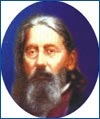Arsenite of Antimony. (Sb2O3) As O5 + 3 p. c.
Prepared first by Papilland and Mousnier and introduced in the Old School practice under the name of antimonial granulations.
Proved by Isnard and Used by Payr in emphysema.
INNER HEAD.
Rush of blood to head.
Pain in forehead.
Pressure in temples.
SIGHT AND EYES.
Pain in orbits.
Inflammation of eyes.
FACE.
dema of face.
APPETITE, THIRST, DESIRES, AVERSIONS.
Loss of appetite.
HICCOUGH, BELCHING, NAUSEA AND VOMITING.
Nausea.
STOOLS AND RECTUM.
Slight diarrhoea, without pain in abdomen.
RESPIRATION.
** Excessive dyspnoea. θ Emphysema.
HEART, PULSE AND CIRCULATION.
Pulse 90.
LOWER LIMBS.
Wandering pains along sciatic nerves.
NERVES.
General sick feeling.
Sense of weakness.
RELATIONS.
Similar to : other antimony salts ; Ammonium carb. ; Arsen. ; Aurum ; Laches. ; Mercurius sulph. ; Phosphor. ; Pulsat. (ischias, wandering pains) ; Sulphur.
“NOTE:
PLAIN TEXT : LOWEST & DESIGNATES AN OCCASIONALLY CONFIRMED SYMPTOMS;
Plain blue: MORE FREQUENTLY CONFIRMED;
BOLD BLUE : SYMPTOMS VERIFIED BY CURES;
BOLD RED : REPEATEDLY VERIFIED;
$BOLD ITALIC RED$ : AN APPROVED CHARACTERISTIC;
θ : STANDS BETWEEN CURED SYMPTOM & PATHOLOGICAL CONDITION;
** : OBSERVED FROM OLD SCHOOL OR NEW SCHOOL;
toxic : Toxicology;
r : Right;
l : Left;
< : Increased or aggravation;
> : Decrease or amelioration;
^^ : Symptoms observed only on the sick “

